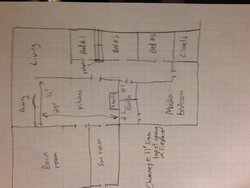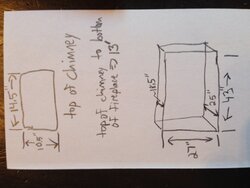I've been lurking and reading on here for a couple of months, and I'm already on my way to becoming a wood hoarder. Last winter's experience burning green wood in an open fireplace convinced us that we need dry wood and a wood stove insert. I'm Oxford, MS, which may seem pretty far south to be worried about heat, but we had a real winter this time around and spent a LOT of money on electricity while still not feeling warm (heat pump). My house is about 2300 sq. ft. on one level (rough sketches included), built in 1973, and has lots of doors and rooms. The room that my hearth is in is a 24x12 kitchen, and it is connected to our living/dining room by a door and 3x6' opening above a kitchen counter. The living room is about 24x15' and has a 12' vaulted ceiling. The rest of the house has 8' ceilings. My fireplace is pretty big: 43X27", 25" deep at the bottom and 18.5" at the top.
Before a trip to a local Buck dealer, I was pretty much set on a mid-size non-cat heater, but the dealer said they have had very good feedback on the Buck 91, which is a pretty big catalytic heater. Their non-cat heater (Buck 81) of the same size is about the same price ($2450), so I don't think they were pushing a certain heater to maximize profit. These folks have been in business for 40 years, and they heat their house and their showroom with wood.
Anyway, I have some specific questions :
1. Would a Buck 91 drive us out of our kitchen while we freeze in other rooms? We have a little practice using fans to move heat/cold around our house.
2. Should we just get a smaller stove and resign ourselves to heating the rest of the house by other means? (while the electric strip on our heat pump makes our meter spin like crazy)
3. Does a catalytic heater need less in the way of chimney lining? The dealer said that only a starter pipe and a blockoff plate would be needed, and it should draw because of the high temp of the gases exiting the cats. (My flue is 14.5X10.5"). If we get the 81, it will cost about $500 more, at least, because of the definite need for a chimney liner.
4. Does the longer burn time and efficiency of a catalytic heater offset the headache of replacing the combustor? If it's $300 every 10 years, it may not be a big deal. I like the idea of a 10 hour burn without adding wood.
Anyway, I've already learned a ton on here, but I feel like I'm at an impasse in the decision process. Any help will be greatly appreciated!
Before a trip to a local Buck dealer, I was pretty much set on a mid-size non-cat heater, but the dealer said they have had very good feedback on the Buck 91, which is a pretty big catalytic heater. Their non-cat heater (Buck 81) of the same size is about the same price ($2450), so I don't think they were pushing a certain heater to maximize profit. These folks have been in business for 40 years, and they heat their house and their showroom with wood.
Anyway, I have some specific questions :
1. Would a Buck 91 drive us out of our kitchen while we freeze in other rooms? We have a little practice using fans to move heat/cold around our house.
2. Should we just get a smaller stove and resign ourselves to heating the rest of the house by other means? (while the electric strip on our heat pump makes our meter spin like crazy)
3. Does a catalytic heater need less in the way of chimney lining? The dealer said that only a starter pipe and a blockoff plate would be needed, and it should draw because of the high temp of the gases exiting the cats. (My flue is 14.5X10.5"). If we get the 81, it will cost about $500 more, at least, because of the definite need for a chimney liner.
4. Does the longer burn time and efficiency of a catalytic heater offset the headache of replacing the combustor? If it's $300 every 10 years, it may not be a big deal. I like the idea of a 10 hour burn without adding wood.
Anyway, I've already learned a ton on here, but I feel like I'm at an impasse in the decision process. Any help will be greatly appreciated!



